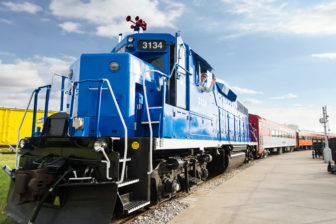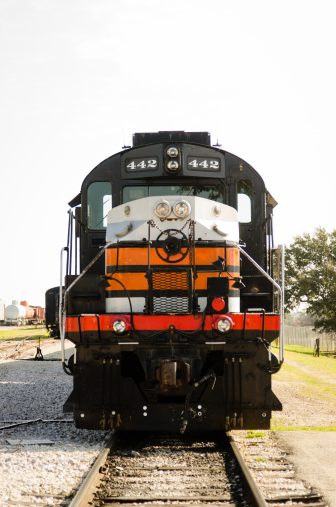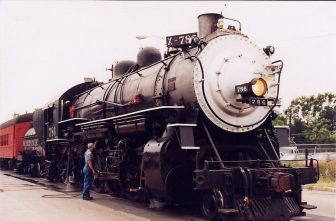EMD GP40-3 Diesel 3134

We are proud to present EMD GP40-3 #3134.
This EMD GP40-3 was overhauled in 2016 after an alternator fire that spread throughout the electrical locker and into the cab. The 3134 was originally on lease from our friends at Horizon Rail. ASTA purchased this locomotive from Horizon Rail in 2024. See more information on our YouTube channel!
The team at Horizon in Euclid, Ohio rebuilt this STUNNING engine, and it is now equipped with a TMV control system, self-load, motor shunting, full diagnostic/self-test functions, motor-cut-out and much more! The cab even got a facelift with fresh interior, Microphor toilet, air conditioning, 110V and 12V power, upgraded seating and heaters. This powerful performance engine boasts of a 16-645-E Engine producing 3,000 horse power!
Want to see the #3134 in action? Check out this Bertram Depot drive-by on our YouTube channel!
Alco Diesel 442
 When the Austin Steam Train Association found itself without a serviceable steam locomotive in July of 1999 we looked to diesel-electric locomotives to continue uninterrupted service. At first, borrowed engines from the local freight carrier sufficed, but a decision was made in 2000 to purchase our own diesel. That process culminated in the acquisition of engine 442.
When the Austin Steam Train Association found itself without a serviceable steam locomotive in July of 1999 we looked to diesel-electric locomotives to continue uninterrupted service. At first, borrowed engines from the local freight carrier sufficed, but a decision was made in 2000 to purchase our own diesel. That process culminated in the acquisition of engine 442.
Built by the same company that built our steam locomotive, 786, in 1916, the American Locomotive Company constructed a series of these six-axle RSD-15 road-switchers in 1960 for the Atchison, Topeka & Santa Fe Railway. Our 442 was built as Santa Fe 842, and was later renumbered 9842. The RSD-15s saw service in all parts of the Santa Fe system, and were gradually retired in the ’70s as the Santa Fe modernized its motive power fleet.
The 9842 was purchased secondhand by the Squaw Creek Coal Company of Indiana and was used to haul heavy coal trains. Our engine later wound up under the care of the Indiana Hi-Rail Corp., where it was again renumbered 442. We purchased the 442 from Indiana Hi-Rail in early 2000. ASTA staff and volunteers rebuilt the 442 for regular service and painted the engine in a modified Southern Pacific “Black Widow” paint scheme. The 2,400-horsepower locomotive is the last known operating example of its class. The Alco RSD-15s are more commonly known to railroad enthusiasts as “alligators” in reference to the locomotives’ long, low noses.
Locomotive 442 went out of service in December 2016 for unexpected restoration. It has been temporarily replaced by locomotive #3134. You can read more about the restoration of the 442 HERE.
Southern Pacific 786
 The SP 786 steam locomotive was completed by the American Locomotive Company’s Brooks Works of Dunkirk, New York in August of 1916. The locomotive was one of the group of 20 Southern Pacific Mk-5 class 2-8-2 Mikados (numbers 775 to 794). SP 786 was placed in service on the Houston & Texas Central subsidiary of the SP in September of 1916.
The SP 786 steam locomotive was completed by the American Locomotive Company’s Brooks Works of Dunkirk, New York in August of 1916. The locomotive was one of the group of 20 Southern Pacific Mk-5 class 2-8-2 Mikados (numbers 775 to 794). SP 786 was placed in service on the Houston & Texas Central subsidiary of the SP in September of 1916.
The locomotive received several upgrades throughout its career, including: original extended smokebox, shortened in the 1920’s, boiler pressure upgraded from 200 to 210 psi at Houston in 1930, and installation of a feedwater heater and superheaters at Houston in 1941.
SP 786 was retired from service and donated to the City of Austin in March of 1956. It was placed on display near the firehouse on Trinity between 4th and 5th streets. It would remain there for 34 years. In 1989 the SP 786 was leased to the newly-formed Austin Steam Train Association and was removed from display the following year. Restoration of the locomotive began in June of 1990 at the Westinghouse Motor Co. shops in Georgetown, Texas. A team of both professional and volunteer crews completed the intense restoration in a relatively brief amount of time. For three days in December 1991 the operational SP 786 and one coach car were at the center of a celebratory festival in downtown Austin. The first passenger excursion pulled by the restored SP 786 arrived in Burnet on July 25, 1992.
After seven years of reliable service, SP 786 was temporarily sidelined in July 1999 following the discovery of cracks in a key component of the locomotive. The cracks, which had apparently started decades ago and worked their way to the surface, will require replacement of the cylinder saddle casting — a task which has not been undertaken in the United States in more than 50 years. You can read more about the restoration of the SP 786 HERE. We are also thrilled to share a video update about this locomotive on our YouTube channel!
